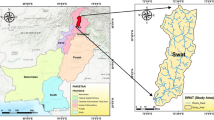Abstract
In Sudan, the prevalence of cancer cases increased and cancer ranked as the major cause of death. Therefore, forming a cancer control program and putting strategic action plans into practice became an important matter for the health industry. The correlation of variations in different societies and environmental factors should be examined spatially with reliable data. The aim of this study is to produce base maps for implementation of cancer control program and cancer density maps through the utilization of GIS in health work. In this study, a database was built with the use of GIS to examine the distribution of cancer cases and maps relating to cancer events in allocation units were created. Cancer cases data registered from 1999 to 2008, by the Institute of Nuclear Medicine and Molecular Biology and Treatment of Tumors—University of Gezira in El Gezira State, was used as case in this study. Using ArcGIS, the distribution of cancer cases were presented on cancer maps including allocation units and incidence values, which were calculated for each villages and locality region. According to the world standards, cancer rates were determined and examined by the spatial analysis power of GIS. The research concluded that cancer cases were increased, in some localities over the past 10 years (1999–2008). This can be related to many reasons including the existence of the Gezira Scheme were farmers used fertilizers and pesticides, as well as increasing health awareness among the citizens through the establishment of use in the state.







Similar content being viewed by others
References
Abbadi, K. H., & Elzorgani, G. A. (1981). Residues of DDT in soil of the Sudan Gezira. 1st international congress for soil pollution and protection from pesticides residues. Egypt: Zagazig University.
Abdelbagi, A. O., Elmahi, M. A., & Osman, D. G. (2000). Chlorinated hydrocarbon insecticide residues in the Sudanese soils of limited or no pesticide use. Arab Journal of Plant Protection, 18, 35–39.
Abdelbagi, A. O., Elmahi, A. M., & Osman, D. G. (2003). Organochlorine insecticides residues in Sudanese soil of intensive pesticide use and in surface soil of Qurashi pesticide store. University of Khartoum Journal of Agricultural Sciences, 11, 59–68.
Boots, B. N., & Getis, A. (1988). Point pattern analysis. Newbury Park, N.J.: SAGE Publications.
Brewer, C. A. (2006). Basic mapping principles for visualizing cancer data using geographic information systems (GIS). American Journal of Preventive Medicine, 30(2), s25–s36.
Cai, Z. (2003). Use of GIS in analyzing environmental cancer risks as a function of geographic scale. University of Arizona. http://math.arizona.edu/~ura-reports/032/Zheng.Cai/Report.htm.
Ebru, C.,Tahsin, Y. (2005). ESRI health GIS conference.
Kulldorff, M. (1997). A spatial scan statistic. Communications in Statistics-Theory and Methods, 26(6), 1481–1496.
Shanmugaratnam, K. (1989). Availability and completeness of cancer registration worldwide. In P. Boyle, C. S. Muir, & E. Grundmann (Eds.), Cancer mapping (pp. 28–33). Heidelberg, NY: Springer.
Shannon, L., Linda, A., Todd, B., Linda, P., & Deborah, W. (2008). Geographic information system for breast cancer studies on long island (LI GIS). 2nd Am Congress, National Cancer institute.
Stern, R. M. (1995). The added value of geographical information systems in public and environmental health. In R. M. Stern (Ed.), Environment and health data in Europe as a tool for risk management: Needs, uses and strategies (pp. 3–24). Boston: Kluwer Academic Publishers.
Tahsin, Y., Ebru, H. C., & Arif, C. A. (2009). Geo-relationship between cancer cases and the environment by GIS: A case study of Trabzon in Turkey. International Journal Environment Research Public Health, 6, 3190–3204. doi:10.3390/ijerph6123190.
Teppo, L. (1998). Problems and possibilities in the use of cancer data by GIS–experience in Finland. In A. C. Gatrell & M. Löytönen (Eds.), GIS and health (pp. 167–177). Philadelphia: Taylor and Francis.
http://www.roseindia.net/technology/gps/health-improvement.shtml Genel Risk Faktleri, 30 May 2005.
http://www.un.org.tr/who/bulten/turk/bul7dsobasin51.htm, Kanser Hastalari Ve Topluluklari Için Yeni Bir Umut (DS/52 Basin Bildirisi, 28 Haziran 2002), 20 May 2005.
http://surveillance.cancer.gov/statistics/types/incidence.html, National Cancer Institute, Cancer Control & Population Sciences, 2005.
Author information
Authors and Affiliations
Corresponding author
Rights and permissions
About this article
Cite this article
Elebead, F.M., Hamid, A., Hilmi, H.S.M. et al. Mapping Cancer Disease Using Geographical Information System (GIS) in Gezira State-Sudan. J Community Health 37, 830–839 (2012). https://doi.org/10.1007/s10900-011-9517-9
Published:
Issue Date:
DOI: https://doi.org/10.1007/s10900-011-9517-9




